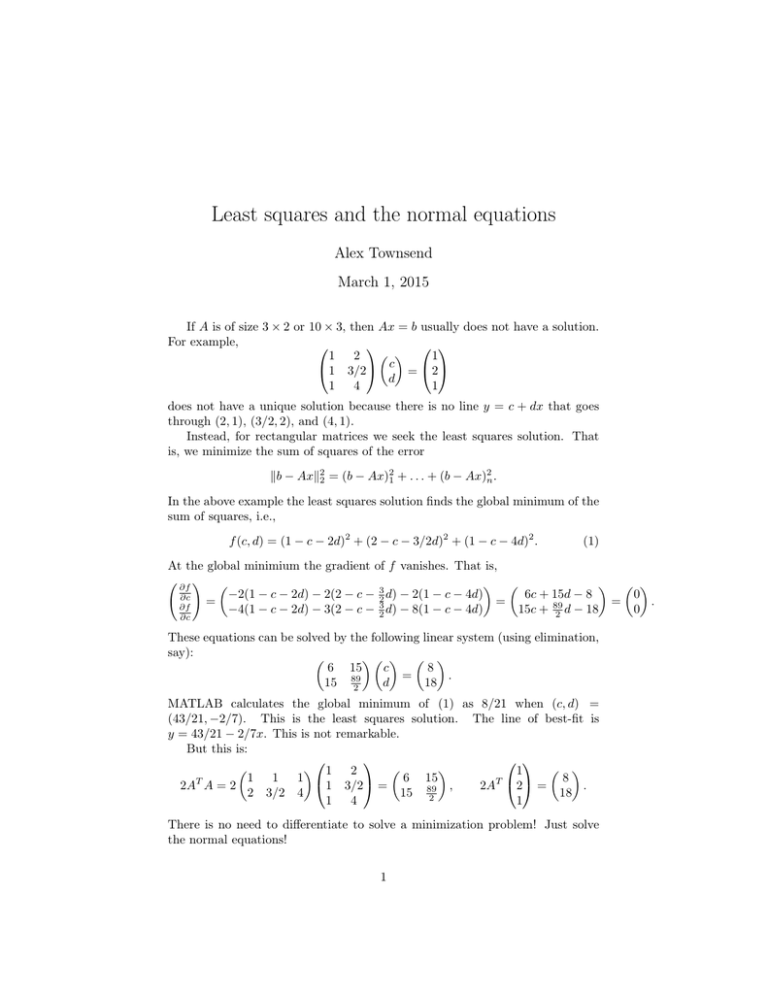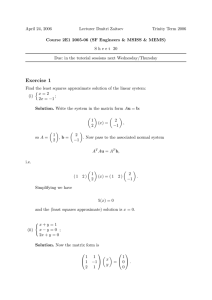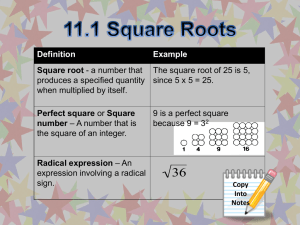Least squares and the normal equations Alex Townsend March 1, 2015
advertisement

Least squares and the normal equations Alex Townsend March 1, 2015 If A is of size 3 × 2 or 10 × 3, then Ax = b usually does not have a solution. For example, 1 2 1 1 3/2 c = 2 d 1 4 1 does not have a unique solution because there is no line y = c + dx that goes through (2, 1), (3/2, 2), and (4, 1). Instead, for rectangular matrices we seek the least squares solution. That is, we minimize the sum of squares of the error kb − Axk22 = (b − Ax)21 + . . . + (b − Ax)2n . In the above example the least squares solution finds the global minimum of the sum of squares, i.e., f (c, d) = (1 − c − 2d)2 + (2 − c − 3/2d)2 + (1 − c − 4d)2 . (1) At the global minimium the gradient of f vanishes. That is, ! ∂f 6c + 15d − 8 −2(1 − c − 2d) − 2(2 − c − 32 d) − 2(1 − c − 4d) 0 ∂c = = = . ∂f 0 d − 18 15c + 89 −4(1 − c − 2d) − 3(2 − c − 32 d) − 8(1 − c − 4d) 2 ∂c These equations can be solved by the following linear system (using elimination, say): 6 15 c 8 = . d 18 15 89 2 MATLAB calculates the global minimum of (1) as 8/21 when (c, d) = (43/21, −2/7). This is the least squares solution. The line of best-fit is y = 43/21 − 2/7x. This is not remarkable. But this is: 1 2 1 6 15 8 1 1 1 T T 2 = 1 3/2 = , 2A 2A A = 2 . 18 2 3/2 4 15 89 2 1 1 4 There is no need to differentiate to solve a minimization problem! Just solve the normal equations! 1 NORMAL EQUATIONS: AT Ax = AT b Why the normal equations? To find out you will need to be slightly crazy and totally comfortable with calculus. In general, we want to minimize1 f (x) = kb − Axk22 = (b − Ax)T (b − Ax) = bT b − xT AT b − bT Ax + xT AT Ax. If x is a global minimum of f , then its gradient ∇f (x) is the zero vector. Let’s take the gradient of f remembering that ∂f ∂x1 ∇f (x) = ... . ∂f ∂xn We have the following three gradients: ∇(xT AT b) = AT b, ∇(bT Ax) = AT b, ∇(xT AT Ax) = 2AT Ax. To calculate these gradients, write out xT AT b, bT Ax, and xT AT Ax, in terms of sums and differentiate with respect to x1 , . . . , xn (this gets very messy). Thus, we have ∇f (x) = 2AT Ax − 2AT b, just like we saw in the example. We can solve ∇f (x) = 0 or, equivalently AT Ax = AT b to find the least squares solution. Magic. Is this the global minimum? Could it be a maximum, a local minimum, or a saddle point? To find out we take the “second derivative” (known as the Hessian in this context): Hf = 2AT A. Next week we will see that AT A is a positive semi-definite matrix and that this implies that the solution to AT Ax = AT b is a global minimum of f (x). Roughly speaking, f (x) is a function that looks like a bowl. 1 Here, x is a vector not a 1D variable. 2






